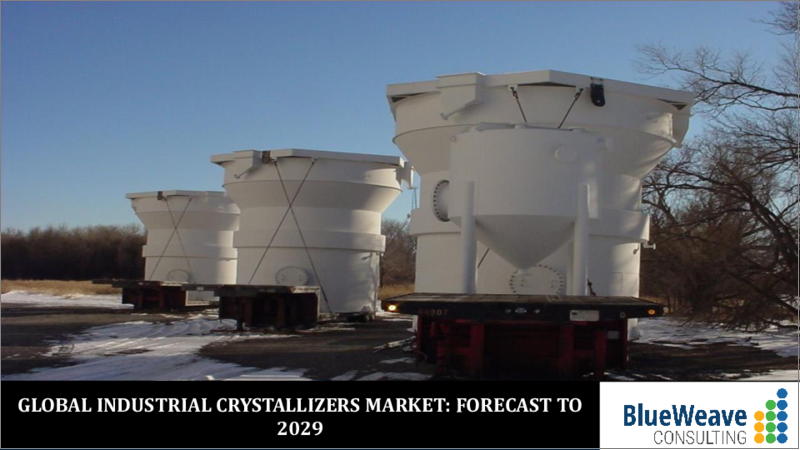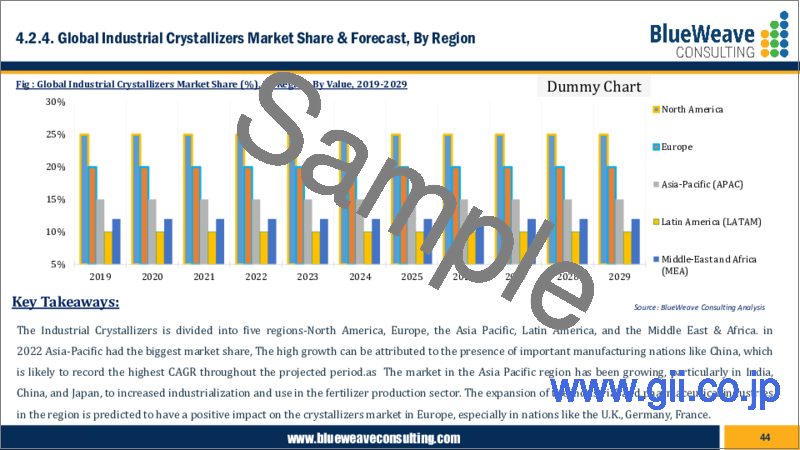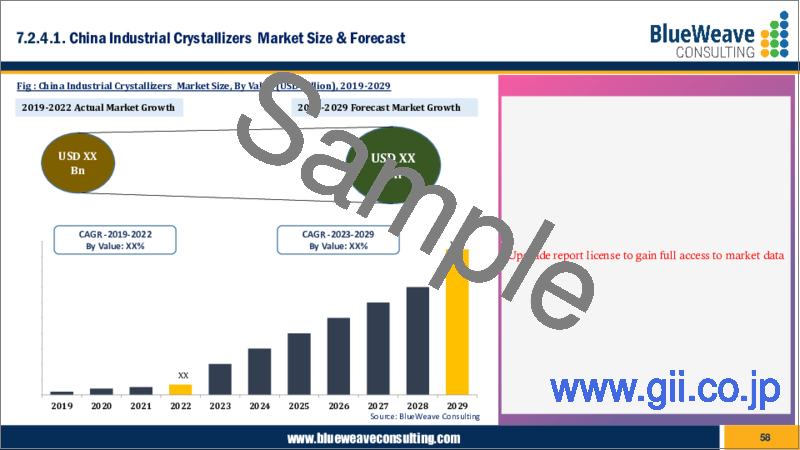|
|
市場調査レポート
商品コード
1134244
産業用晶析装置の世界市場 (2018年~2028年):タイプ・プロセス・用途・地域別の市場規模・シェア・動向分析・機会・予測Industrial Crystallizers Market - Global Size, Share, Trend Analysis, Opportunity and Forecast Report, 2018-2028, Segmented by Type ; Process ; Application ; Region |
||||||
| 産業用晶析装置の世界市場 (2018年~2028年):タイプ・プロセス・用途・地域別の市場規模・シェア・動向分析・機会・予測 |
|
出版日: 2022年09月27日
発行: Blueweave Consulting
ページ情報: 英文 430 Pages
納期: 2~3営業日
|
- 全表示
- 概要
- 目次
世界の産業用晶析装置の市場規模は、2021年の35億米ドルから、予測期間中は5.2%のCAGRで推移し、2028年末には約49億米ドルの規模に成長すると予測されています。
産業用晶析装置の市場は、産業界による廃水処理および廃水管理の増加により拡大しています。さらに、結晶性の食品、医薬品、化学薬品、金属、肥料などの生産および精製における産業用晶析装置の使用も予測期間中の市場成長を後押ししています。
当レポートでは、世界の産業用晶析装置の市場を調査し、市場概要、市場成長への各種影響因子の分析、技術動向、法規制環境、市場規模の推移・予測、各種区分・地域/主要国別の内訳、競合環境、主要企業のプロファイルなどをまとめています。
目次
第1章 調査の枠組み
第2章 エグゼクティブサマリー
第3章 世界の産業用晶析装置市場の洞察
- 産業バリューチェーン分析
- DROC分析
- 促進要因
- 抑制要因
- 機会
- 課題
- 技術の進歩/最近の開発
- 規制の枠組み
- ポーターのファイブフォース分析
第4章 世界の産業用晶析装置市場:概要
- 市場規模・予測
- 市場シェア・予測
- タイプ別
- 冷却晶析装置
- 蒸発晶析装置
- DTB晶析装置
- その他
- プロセス別
- 連続式
- バッチ式
- 用途別
- 医薬品
- 肥料
- 農薬
- 発電所
- 水処理
- 食品・飲料
- 金属・鉱物
- その他(化学品・発電所・建設など)
- 地域別
- 北米
- 欧州
- アジア太平洋
- ラテンアメリカ
- 中東・アフリカ
- タイプ別
第5章 北米の産業用晶析装置市場
- 市場規模・予測
- 市場シェア・予測
- タイプ別
- プロセス別
- 用途別
- 国別
第6章 欧州の産業用晶析装置市場
- 市場規模・予測
- 市場シェア・予測
- タイプ別
- プロセス別
- 用途別
- 国別
第7章 アジア太平洋の産業用晶析装置市場
- 市場規模・予測
- 市場シェア・予測
- タイプ別
- プロセス別
- 用途別
- 国別
第8章 ラテンアメリカの産業用晶析装置市場
- 市場規模・予測
- 市場シェア・予測
- タイプ別
- プロセス別
- 用途別
- 国別
第9章 中東・アフリカの産業用晶析装置市場
- 市場規模・予測
- 市場シェア・予測
- タイプ別
- プロセス別
- 用途別
- 国別
第10章 競合情勢
- 主要企業・製品のリスト
- 企業シェア分析
- 競合ベンチマーキング:経営パラメーター別
- 主要な戦略的展開 (M&A・提携など)
第11章 COVID-19:世界の産業用晶析装置市場に与える影響
第12章 企業プロファイル (会社概要・財務マトリックス・競合情勢・主要人材・主な競合相手・連絡先・戦略的展望)
- Veolia Water Technologies
- Sumitomo Heavy Industries, Ltd.
- Suez Water Technologies & Solutions
- Gea Group Ag
- Sulzer Ltd.
- Tsukishima Kikai Co., Ltd.
- Fives Group
- Condorchem Envitech
- Piovan S.P.A
- Alaqua Inc.
- Vobis Llc
- Anssen Metallurgy Group C0., Ltd.
- Ebner Gmbh & Co. Kg
- Moretto Spa
- Motan Colortronic
- Technoforce Llc
- Whiting Equipment Canada, Inc
- Shaanxi Aerospace Power Hi-Tech Co., Ltd.
- Maschinenbau Gmbh
- 他の有力企業
第13章 主な戦略的提言
第14章 調査手法
Global Industrial Crystallizers Market to Grow at a CAGR of 5.2% during Forecast Period
Global Industrial Crystallizers Market is growing at a high CAGR because of the increased use of industrial crystallizers by end-use industries such as food & beverage, pharmaceutical, wastewater treatment, chemicals and fertilizers, power plants, agrochemicals, metal and minerals, construction industries, etc.
A recent study conducted by the strategic consulting and market research firm, BlueWeave Consulting, revealed that the Global Industrial Crystallizers Market was worth USD 3.5 billion in the year 2021. The market is projected to grow at a CAGR of 5.2%, earning revenues of around USD 4.9 billion by the end of 2028. The global industrial crystallizers market is growing due to the increase in wastewater treatment and wastewater management by industries. Moreover, the use of industrial crystallizers in the production and purification of crystalline foods, drugs, chemicals, metals, fertilizers, etc., is also driving the growth of the global industrial crystallizers market during the forecast period 2022-2028.
Growing Pharmaceutical Activities to Drive Market Growth
Crystallization is a key operation in pharmaceuticals' processing, development, and manufacturing. Crystallizers are used in the formation of the pharmaceutical product, purification of intermediates, separation of intermediates and Active Pharmaceutical Ingredients (APIs), prevention of crystallization in amorphous products, etc. The crystallization process in pharmaceuticals is complex; it is developed by evaluating the type of equipment, solvent quality, recovering the solvent, maintaining temperature, time for reflux, effects of seeds, stirring RPM control, purification, and concentration of mother liquor. It is an essential step in the development of over 80% of drug products as it can control the size of crystals.
Challenge: Disruption in Supply Chain
Industrial crystallizers are made of stainless steel. Unfortunately, there is a shortage in the global supply of semi-finished stainless steel and aluminum goods. Due to the shortage of raw materials, the price of stainless steel is on the rise. This is challenging the procurement, manufacturing, sales, and distribution of industrial crystallizers. This is a major challenge for the key market players.
Global Industrial Crystallizers Market - By Application
Based on application, the global industrial crystallizers market is segmented into pharmaceuticals, fertilizers, agrochemicals, power plants, water treatment, food & beverage, metal & minerals, and others (chemicals, power plants, construction, etc.). Amidst the segmentation, the pharmaceuticals segment dominated the global industrial crystallizers market share in 2021 due to the large-scale use of industrial crystallizers in API manufacturing. On the other hand, the food & beverage segment is estimated to grow at the highest rate in the forecast period 2022-2028 as crystallizers are greatly used for the production of sugar, edible oil, juices, etc.
Global Industrial Crystallizers Market - Regional Insights
Based on regions, the global industrial crystallizers market has been segmented into five categories- North America, Europe, Asia-Pacific, Latin America, Middle East, and Africa. Amidst the segmentation, Asia-Pacific dominated the global industrial crystallizers market share in 2021 and is estimated to grow at the highest rate during the forecast period. This is due to the presence of major manufacturing countries like India and China in the Asia-Pacific region.
Impact of COVID-19 on Global Industrial Crystallizers Market
Like the majority of the industries, the global industrial crystallizers market was negatively impacted during the COVID-19 pandemic as it is dependent on other end-use industries like food & beverage, pharmaceutical, chemicals and fertilizers, power plants, metal, and minerals. The outbreak of the infectious SARS CoV-2 led to worldwide lockdown measures and adversely affected all these sectors. Industrial crystallizer-producing companies were compelled to downsize as the demand for industrial crystallizers fell. As a result, the laborers were also displaced to their native places. The world was facing a global economic recession as the supply chain was disrupted. The need for a cure for the COVID-19 virus increased the demand for industrial crystallizers in the pharmaceutical industry. This is because industrial crystallizers are used in the formation of the pharmaceutical product and purification and separation of intermediates and APIs. Moreover, the demand for industrial crystallizers is continuously increasing post-Covid due to increased usage in wastewater treatment, food & beverage industries, pharmaceutical industries, etc.
Competitive Landscape
Veolia Water Technologies, Sumitomo Heavy Industries, Ltd., Suez Water Technologies & Solutions, Gea Group Ag, Sulzer Ltd., Tsukishima Kikai Co., Ltd., Fives Group, Condorchem Envitech, Piovan S.P.A, Alaqua Inc., Vobis Llc., Anssen Metallurgy Group C0., Ltd., Ebner Gmbh & Co. Kg, Moretto Spa, Motan Colortronic, Technoforce Llc., Whiting Equipment Canada, Inc., Shaanxi Aerospace Power Hi-Tech Co., Ltd., Diamat Maschinenbau Gmbh are the key players operating in global industrial crystallizers market. Companies like Veolia Water Technologies and Suez Water Technologies & Solutions have expertise in treatment of industrial wastewater and in achieving Zero Liquid Discharge. Commissioning, collaborations, alliances, contracts, partnerships, research and development, and product diversification are the most important strategies taken up by these companies.
The in-depth analysis of the report provides information about growth potential, upcoming trends, and statistics of the global industrial crystallizers market. It also highlights the factors driving forecasts of total market size. The report promises to provide recent technology trends in the global Industrial Crystallizers market and industry insights to help decision-makers make sound strategic decisions. Furthermore, the report also analyzes the growth drivers, challenges, and competitive dynamics of the market.
Table of Contents
1. Research Framework
- 1.1. Research Objective
- 1.2. Type Overview
- 1.3. Market Segmentation
2. Executive Summary
3. Global Industrial Crystallizers Market Insights
- 3.1. Application Value Chain Analysis
- 3.2. DROC Analysis
- 3.2.1. Growth Drivers
- 3.2.1.1. Increase in Wastewater Treatment and Increasing Adoption of ZLD In Industries
- 3.2.1.2. Growth of Food & Beverage Application
- 3.2.1.3. Increasing Crystallization Activities to Promote Product Adoption
- 3.2.2. Restraints
- 3.2.2.1. High Cost of Crystallization Manufacturing and Maintenance
- 3.2.2.2. Lack of Skilled Labor
- 3.2.3. Opportunities
- 3.2.3.1. High Demand from Metal & Mineral and Agrochemical Sectors in Developing Regions
- 3.2.3.2. Growing Pharmaceutical Activities
- 3.2.4. Challenges
- 3.2.4.1. Highly Fragmented Market
- 3.2.4.2. Disruption in Supply Chain
- 3.2.1. Growth Drivers
- 3.3. Technological Advancement/Recent Development
- 3.4. Regulatory Framework
- 3.5. Porter's Five Forces Analysis
- 3.5.1. Bargaining Power of Suppliers
- 3.5.2. Bargaining Power of Buyers
- 3.5.3. Threat of New Entrants
- 3.5.4. Threat of Substitutes
- 3.5.5. Intensity of Rivalry
4. Global Industrial Crystallizers Market Overview
- 4.1. Market Size & Forecast by Value, 2018-2028
- 4.1.1. By Value (USD Billion)
- 4.2. Market Share & Forecast
- 4.2.1. By Type
- 4.2.1.1. Cooling Crystallizer
- 4.2.1.2. Evaporative Crystallizer
- 4.2.1.3. DTB Crystallizer
- 4.2.1.4. Others
- 4.2.2. By Process
- 4.2.2.1. Continuous
- 4.2.2.2. Batch
- 4.2.3. By Application
- 4.2.3.1. Pharmaceuticals
- 4.2.3.2. Fertilizers
- 4.2.3.3. Agrochemical
- 4.2.3.4. Power Plant
- 4.2.3.5. Water Treatment
- 4.2.3.6. Food & Beverage
- 4.2.3.7. Metal & Minerals
- 4.2.3.8. Others (Chemicals, Power Plant, Construction, etc.)
- 4.2.4. By Region
- 4.2.4.1. North America
- 4.2.4.2. Europe
- 4.2.4.3. Asia Pacific
- 4.2.4.4. Latin America
- 4.2.4.5. Middle East and Africa
- 4.2.1. By Type
5. North America Industrial Crystallizers Market
- 5.1.1. Market Size & Forecast by Value, 2018-2028
- 5.1.2. By Value (USD Billion)
- 5.2. Market Share & Forecast
- 5.2.1. By Type
- 5.2.2. By Process
- 5.2.3. By Application
- 5.2.4. By Country
- 5.2.4.1. US
- 5.2.4.1.1. By Type
- 5.2.4.1.2. By Process
- 5.2.4.1.3. By Application
- 5.2.4.2. Canada
- 5.2.4.2.1. By Type
- 5.2.4.2.2. By Process
- 5.2.4.2.3. By Application
6. Europe Industrial Crystallizers Market
- 6.1. Market Size & Forecast by Value, 2018-2028
- 6.1.1. By Value (USD Billion)
- 6.2. Market Share & Forecast
- 6.2.1. By Type
- 6.2.2. By Process
- 6.2.3. By Application
- 6.2.4. By Country
- 6.2.4.1. Germany
- 6.2.4.1.1. By Type
- 6.2.4.1.2. By Process
- 6.2.4.1.3. By Application
- 6.2.4.2. UK
- 6.2.4.2.1. By Type
- 6.2.4.2.2. By Process
- 6.2.4.2.3. By Application
- 6.2.4.3. Italy
- 6.2.4.3.1. By Type
- 6.2.4.3.2. By Process
- 6.2.4.3.3. By Application
- 6.2.4.4. France
- 6.2.4.4.1. By Type
- 6.2.4.4.2. By Process
- 6.2.4.4.3. By Application
- 6.2.4.5. Spain
- 6.2.4.5.1. By Type
- 6.2.4.5.2. By Process
- 6.2.4.5.3. By Application
- 6.2.4.6. The Netherlands
- 6.2.4.6.1. By Type
- 6.2.4.6.2. By Process
- 6.2.4.6.3. By Application
- 6.2.4.7. Belgium
- 6.2.4.7.1. By Type
- 6.2.4.7.2. By Process
- 6.2.4.7.3. By Application
- 6.2.4.8. NORDIC Countries
- 6.2.4.8.1. By Type
- 6.2.4.8.2. By Process
- 6.2.4.8.3. By Application
- 6.2.4.9. Rest of Europe
- 6.2.4.9.1. By Type
- 6.2.4.9.2. By Process
- 6.2.4.9.3. By Application
7. Asia Pacific Industrial Crystallizers Market
- 7.1. Market Size & Forecast by Value, 2018-2028
- 7.1.1. By Value (USD Billion)
- 7.2. Market Share & Forecast
- 7.2.1. By Type
- 7.2.2. By Process
- 7.2.3. By Application
- 7.2.4. By Country
- 7.2.4.1. China
- 7.2.4.1.1. By Type
- 7.2.4.1.2. By Process
- 7.2.4.1.3. By Application
- 7.2.4.2. India
- 7.2.4.2.1. By Type
- 7.2.4.2.2. By Process
- 7.2.4.2.3. By Application
- 7.2.4.3. Japan
- 7.2.4.3.1. By Type
- 7.2.4.3.2. By Process
- 7.2.4.3.3. By Application
- 7.2.4.4. South Korea
- 7.2.4.4.1. By Type
- 7.2.4.4.2. By Process
- 7.2.4.4.3. By Application
- 7.2.4.5. Australia & New Zealand
- 7.2.4.5.1. By Type
- 7.2.4.5.2. By Process
- 7.2.4.5.3. By Application
- 7.2.4.6. Indonesia
- 7.2.4.6.1. By Type
- 7.2.4.6.2. By Process
- 7.2.4.6.3. By Application
- 7.2.4.7. Malaysia
- 7.2.4.7.1. By Type
- 7.2.4.7.2. By Process
- 7.2.4.7.3. By Application
- 7.2.4.8. Singapore
- 7.2.4.8.1. By Type
- 7.2.4.8.2. By Process
- 7.2.4.8.3. By Application
- 7.2.4.9. Philippines
- 7.2.4.9.1. By Type
- 7.2.4.9.2. By Process
- 7.2.4.9.3. By Application
- 7.2.4.10. Vietnam
- 7.2.4.10.1. By Type
- 7.2.4.10.2. By Process
- 7.2.4.10.3. By Application
- 7.2.4.11. Rest of Asia Pacific
- 7.2.4.11.1. By Type
- 7.2.4.11.2. By Process
- 7.2.4.11.3. By Application
8. Latin America Industrial Crystallizers Market
- 8.1. Market Size & Forecast by Value, 2018-2028
- 8.1.1. By Value (USD Billion)
- 8.2. Market Share & Forecast
- 8.2.1. By Type
- 8.2.2. By Process
- 8.2.3. By Application
- 8.2.4. By Country
- 8.2.4.1. Brazil
- 8.2.4.1.1. By Type
- 8.2.4.1.2. By Process
- 8.2.4.1.3. By Application
- 8.2.4.2. Mexico
- 8.2.4.2.1. By Type
- 8.2.4.2.2. By Process
- 8.2.4.2.3. By Application
- 8.2.4.3. Argentina
- 8.2.4.3.1. By Type
- 8.2.4.3.2. By Process
- 8.2.4.3.3. By Application
- 8.2.4.4. Peru
- 8.2.4.4.1. By Type
- 8.2.4.4.2. By Process
- 8.2.4.4.3. By Application
- 8.2.4.5. Colombia
- 8.2.4.5.1. By Type
- 8.2.4.5.2. By Process
- 8.2.4.5.3. By Application
- 8.2.4.6. Rest of Latin America
- 8.2.4.6.1. By Type
- 8.2.4.6.2. By Process
- 8.2.4.6.3. By Application
9. Middle East & Africa Industrial Crystallizers Market
- 9.1. Market Size & Forecast by Value, 2018-2028
- 9.1.1. By Value (USD Billion)
- 9.2. Market Share & Forecast
- 9.2.1. By Type
- 9.2.2. By Process
- 9.2.3. By Application
- 9.2.4. By Country
- 9.2.4.1. Saudi Arabia
- 9.2.4.1.1. By Type
- 9.2.4.1.2. By Process
- 9.2.4.1.3. By Application
- 9.2.4.2. UAE
- 9.2.4.2.1. By Type
- 9.2.4.2.2. By Process
- 9.2.4.2.3. By Application
- 9.2.4.3. Qatar
- 9.2.4.3.1. By Type
- 9.2.4.3.2. By Process
- 9.2.4.3.3. By Application
- 9.2.4.4. Kuwait
- 9.2.4.4.1. By Type
- 9.2.4.4.2. By Process
- 9.2.4.4.3. By Application
- 9.2.4.5. Iran
- 9.2.4.5.1. By Type
- 9.2.4.5.2. By Process
- 9.2.4.5.3. By Application
- 9.2.4.6. South Africa
- 9.2.4.6.1. By Type
- 9.2.4.6.2. By Process
- 9.2.4.6.3. By Application
- 9.2.4.7. Nigeria
- 9.2.4.7.1. By Type
- 9.2.4.7.2. By Process
- 9.2.4.7.3. By Application
- 9.2.4.8. Kenya
- 9.2.4.8.1. By Type
- 9.2.4.8.2. By Process
- 9.2.4.8.3. By Application
- 9.2.4.9. Egypt
- 9.2.4.9.1. By Type
- 9.2.4.9.2. By Process
- 9.2.4.9.3. By Application
- 9.2.4.10. Morocco
- 9.2.4.10.1. By Type
- 9.2.4.10.2. By Process
- 9.2.4.10.3. By Application
- 9.2.4.11. Algeria
- 9.2.4.11.1. By Type
- 9.2.4.11.2. By Process
- 9.2.4.11.3. By Application
- 9.2.4.12. Rest of Middle East & Africa
- 9.2.4.12.1. By Type
- 9.2.4.12.2. By Process
- 9.2.4.12.3. By Application
10. Competitive Landscape
- 10.1. List of Key Players and Their Offerings
- 10.2. Global Industrial Crystallizers Company Share Analysis, 2021
- 10.3. Competitive Benchmarking, By Operating Parameters
- 10.4. Key Strategic Developments (Mergers, Acquisitions, Partnerships, etc.)
11. Impact of Covid-19 on Global Industrial Crystallizers Market
12. Company Profile (Company Overview, Financial Matrix, Competitive landscape, Key Personnel, Key Competitors, Contact Address, and Strategic Outlook)
- 12.1. Veolia Water Technologies
- 12.2. Sumitomo Heavy Industries, Ltd.
- 12.3. Suez Water Technologies & Solutions
- 12.4. Gea Group Ag
- 12.5. Sulzer Ltd.
- 12.6. Tsukishima Kikai Co., Ltd.
- 12.7. Fives Group
- 12.8. Condorchem Envitech
- 12.9. Piovan S.P.A
- 12.10. Alaqua Inc.
- 12.11. Vobis Llc
- 12.12. Anssen Metallurgy Group C0., Ltd.
- 12.13. Ebner Gmbh & Co. Kg
- 12.14. Moretto Spa
- 12.15. Motan Colortronic
- 12.16. Technoforce Llc
- 12.17. Whiting Equipment Canada, Inc
- 12.18. Shaanxi Aerospace Power Hi-Tech Co., Ltd.
- 12.19. Diamat Maschinenbau Gmbh
- 12.20. Other Prominent Players
13. Key Strategic Recommendations
14. Research Methodology
- 14.1. Qualitative Research
- 14.1.1. Primary & Secondary Research
- 14.2. Quantitative Research
- 14.3. Market Breakdown & Data Triangulation
- 14.3.1. Secondary Research
- 14.3.2. Primary Research
- 14.4. Breakdown of Primary Research Respondents, By Region
- 14.5. Assumptions & Limitations




